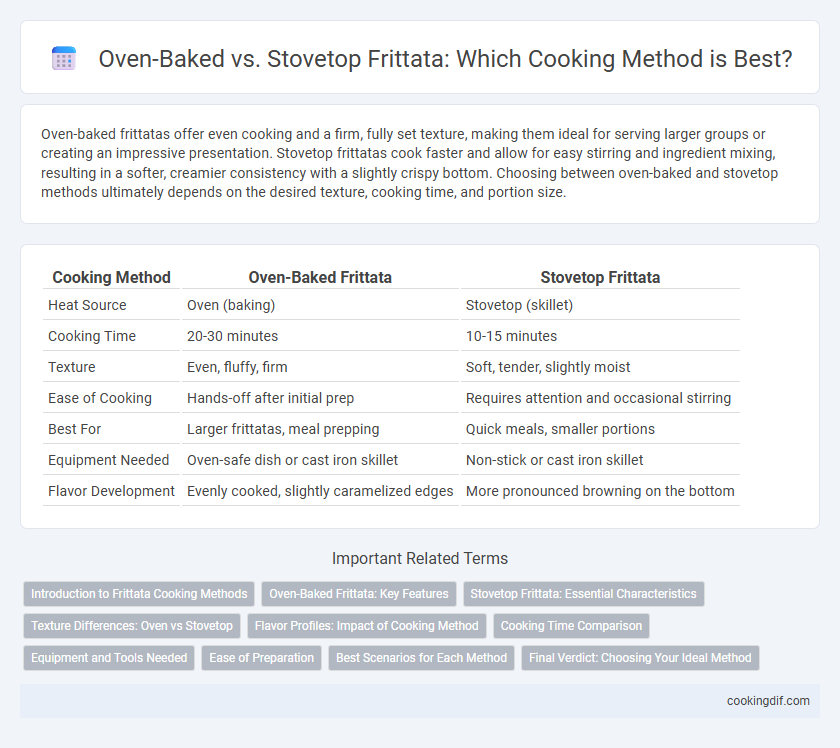Oven-baked frittatas offer even cooking and a firm, fully set texture, making them ideal for serving larger groups or creating an impressive presentation. Stovetop frittatas cook faster and allow for easy stirring and ingredient mixing, resulting in a softer, creamier consistency with a slightly crispy bottom. Choosing between oven-baked and stovetop methods ultimately depends on the desired texture, cooking time, and portion size.
Table of Comparison
| Cooking Method | Oven-Baked Frittata | Stovetop Frittata |
|---|---|---|
| Heat Source | Oven (baking) | Stovetop (skillet) |
| Cooking Time | 20-30 minutes | 10-15 minutes |
| Texture | Even, fluffy, firm | Soft, tender, slightly moist |
| Ease of Cooking | Hands-off after initial prep | Requires attention and occasional stirring |
| Best For | Larger frittatas, meal prepping | Quick meals, smaller portions |
| Equipment Needed | Oven-safe dish or cast iron skillet | Non-stick or cast iron skillet |
| Flavor Development | Evenly cooked, slightly caramelized edges | More pronounced browning on the bottom |
Introduction to Frittata Cooking Methods
Oven-baked frittatas offer even heat distribution that ensures a uniformly cooked, fluffy texture with a slightly browned top, ideal for serving large groups. Stovetop frittatas typically cook faster, allowing for quick browning and easy incorporation of ingredients, but may require careful monitoring to avoid burning. Both methods highlight different textures and flavors, emphasizing the versatility of the Italian egg-based dish.
Oven-Baked Frittata: Key Features
Oven-baked frittatas offer even heat distribution, ensuring a uniformly cooked texture with a golden, slightly crisp top. This method allows for consistent cooking of thicker mixtures without stirring, preserving the integrity of added ingredients like vegetables, cheese, and meats. Baking also enables hands-off preparation, freeing time and reducing the risk of burning compared to stovetop cooking.
Stovetop Frittata: Essential Characteristics
Stovetop frittatas are characterized by their quick cooking time and ability to develop a tender, slightly creamy texture due to gentle heat control. This method allows for greater interaction with ingredients as the eggs cook evenly without browning excessively, preserving delicate flavors. Unlike oven-baked versions, stovetop frittatas often require careful monitoring and occasional stirring to prevent uneven cooking and sticking.
Texture Differences: Oven vs Stovetop
Oven-baked frittatas develop a firm, evenly cooked texture with a golden, slightly crispy top and tender interior due to the consistent, surrounding heat. Stovetop frittatas tend to have a softer, creamier center with a lightly browned bottom, resulting from direct heat and frequent stirring or folding. Choosing oven baking enhances a uniform, sliceable dish, while stovetop methods yield a fluffier, more delicate finish.
Flavor Profiles: Impact of Cooking Method
Oven-baked frittatas develop a richer, more evenly cooked flavor with a slightly browned, custardy texture that enhances the blend of eggs and fillings. Stovetop frittatas tend to have a more pronounced caramelization on the bottom, offering a crispy texture and smoky undertones that intensify the savory notes. The baking method allows for gentle heat infusion, preserving delicate herbs and cheese flavors, while stovetop cooking concentrates savory and toasted elements through direct heat.
Cooking Time Comparison
Oven-baked frittatas generally require 15 to 25 minutes at 350degF (175degC), allowing even cooking and a firm texture. Stovetop frittatas cook significantly faster, often ready within 8 to 12 minutes over medium heat, but may result in a slightly softer center. Choosing between methods depends on desired texture and available cooking time.
Equipment and Tools Needed
Oven-baked frittatas require an oven-safe skillet or baking dish and an oven preheated to around 350degF (175degC), ensuring even cooking and a firm, set texture. Stovetop frittatas need a non-stick or cast-iron skillet with a lid to cook over medium-low heat, allowing gradual setting without burning. Both methods benefit from a rubber spatula for gently lifting edges and a whisk or fork for mixing eggs thoroughly.
Ease of Preparation
Oven-baked frittatas offer a hands-off cooking method, requiring minimal attention and delivering evenly cooked results ideal for serving multiple portions. Stovetop frittatas demand more active monitoring and precise heat control to prevent sticking or burning, which can complicate preparation. Choosing oven baking enhances ease of preparation, making it preferable for consistent texture and straightforward cooking.
Best Scenarios for Each Method
Oven-baked frittatas excel in scenarios requiring even cooking and a firm, set texture, ideal for serving multiple guests or preparing ahead for brunch gatherings. Stovetop frittatas are best suited for quick meals and smaller portions, allowing greater control over browning and texture with faster preparation times. Selecting the cooking method depends on desired consistency, serving size, and time constraints.
Final Verdict: Choosing Your Ideal Method
Oven-baked frittatas offer even cooking and a firm, custard-like texture, ideal for larger portions and a hands-off approach. Stovetop frittatas provide quicker results with a more tender, slightly crispy edge, perfect for smaller batches and immediate serving. The choice depends on desired texture, cooking time, and portion size, with oven baking suited for gatherings and stovetop for everyday meals.
Oven-baked vs Stovetop for cooking method Infographic

 cookingdif.com
cookingdif.com